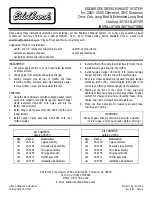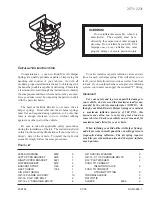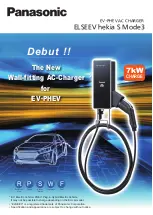
SECTION H -FINAL OPERATIONS -
151
AT LOW SPEEDS
Our standard fan is adequate for practically any small block
engine under normal conditions – and OK for mild FE
engines under 90
F-ambient conditions. If you expect high
temperature city driving, or you have a large displacement
and/or highly tweaked engine, consider ordering our heavy-
duty fan. Alternately, the effectiveness of the heavy-duty
fan is approximated by the combination of the standard rear
fan plus the optional dual front fans. See page 90.
The fan only effects water temperature when the car is below
15mph.
Test the fan function:
The fan thermo-switch is in the aluminum connector
between the radiator and water pump. Because the sensor
is in the coolant return line, the 75
C switch marking will
not correspond to the cylinder head temperature that the
gage indicates because of the cooling that occurs in the
radiator.
After starting and running the car up to operating
temperature (180
F min.), use the dash (manual over-ride)
switch to manually turn the radiator fan on. The
temperature should stabilize somewhat under 210
F,
depending on your ambient temperature. Shut the over-ride
switch off and allow the fan to come on automatically.
This should happen about 200
F -210
F. If the fan does
not start, even at 220
F, check the electrical circuits
involved.
Once the temperature drops, the fan will automatically
cycle off
. The fan will run even with the ignition off
, but
will normally stop within 5 minutes. This feature helps
prevent “hot soak” fuel percolation in the carburetor.
Check for exhaust leaks.
Re-torque the exhaust manifold bolts.
Check the hand brake. This disk brake system
may require more effort than your "other" car.
HEADLIGHT ADJUSTMENT
Most service stations have a standard set of headlight
adjusters. If you have a flat area (at least 40 ft long) you
can do the job yourself.
Remove the screw at the bottom of the trim ring, and
pry off the ring with a flat screwdriver.
Change the vertical/horizontal orientation with the
adjusting screws at the top and side of the headlight
retaining ring. See the diagram below.
Replace the trim ring and screw.
CONGRATULATIONS!
You have just assembled a complete automobile from the ground
up! Your E.R.A. will give you the exhilaration and uniqueness of an outstanding, high
performance automobile. Enjoy!
YOUR FIRST DRIVE
The E.R.A. 427 is an amazing sports car, but it requires caution and care to drive, especially in the beginning when you’re not
accustomed to the power. The Loud Pedal is your friend and your enemy! If you add throttle, the car will react as you would
expect: with more or less wheelspin. Where people get in trouble is with trailing throttle. If you back off too quickly in a corner
(or if the car is already sideways from over-throttle), the rear end will snap around as much as with excess throttle! Squeeze on,
squeeze off! A good driving reference is at this site:
http://www.drivingfast.net/
So – Be Careful Out There, But Always Have Fun!
See page 158 for hints on inspection, insurance and registration.
Summary of Contents for 427 ROADSTER
Page 4: ...SECTION A PARTS NEEDED 4...
Page 13: ...SECTION A PARTS NEEDED 13...
Page 55: ...55 SECTION C CHASSIS PREPARATION Assembling the chassis and preparation for paint...
Page 56: ...56...
Page 70: ...70 SECTION E BODY PREPARATION...
Page 73: ...SECTION E BODY PREPARATION 73...
Page 76: ...SECTION E BODY PREPARATION 76 ebod stripe...
Page 95: ...95 SECTION F SUSPENSION ASSEMBLY...
Page 107: ...107 SECTION G BODY INTERIOR...
Page 117: ...SECTION G BODY INTERIOR 117 eint tunnel...
Page 142: ...142 SECTION H FINAL OPERATIONS...















































